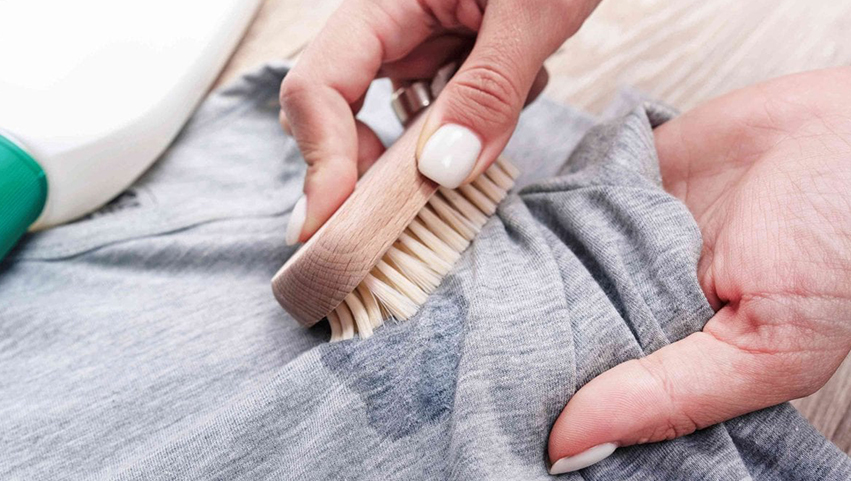Oil-based paint stains are a common issue, particularly on clothes. These types of stains are usually more stubborn and difficult to remove than water-based paints. However, it is possible to remove these stains with the right methods. Here are some techniques you can use to remove oil-based paint stains:
Act quickly:
When an oil-based paint stain appears, it is essential to act fast. Try to remove the stain as soon as possible. The longer you wait, the more difficult it will be to remove the stain.
Protect the area around the stain:
Before attempting to remove the stain, apply a little dishwashing detergent or soapy water around the area to protect the surrounding fabric. This will prevent the stain from spreading to other areas.
Use dishwashing detergent or liquid soap:
Dishwashing detergent or liquid soap is an effective method for removing oil-based paint stains. Pour a little dishwashing detergent or liquid soap on the stain and scrub it with a brush or sponge. Then rinse the stain with cold water.
Use vinegar:
Vinegar is another effective method for removing oil-based paint stains. Pour some white vinegar on the stain and scrub it with a sponge or brush. Wait a few minutes and then rinse the stain with cold water.
Use alcohol:
Alcohol is another effective method for removing oil-based paint stains. Pour a little alcohol on a cotton ball and lightly rub it on the stain. Then rinse the stain with cold water.
Use oil-based solvents:
There are solvents specifically designed to remove oil-based paint stains. It is important to follow the instructions before using these solvents. Also, make sure to choose the solvent that is suitable for the stain color, fabric type, and type of paint.
Removing oil-based paint stains can be challenging, but it is possible with the right techniques and quick action. You can easily remove oil-based paint stains by using one of the above methods. Keep reading for more detailed instructions.
 How to Remove Oil Paint Stains
How to Remove Oil Paint Stains
Removing oil paint stains from clothes is a challenging task. Since the solvents used in this process can be toxic, it is important to have good ventilation in the room where you will be working. Also, you can protect your health by using personal protective equipment such as gloves and a mask.
First, place your garment on a clean unused cloth. Then, moisten the area with oil-based solvent such as turpentine or benzine. This will soften the paint and make it easier to remove. However, you should be careful not to spread the paint to other areas, especially on colored fabrics.
After waiting for a few minutes, gently scrape off the paint from the garment with a knife or palette. You should be careful while doing this and try not to stain the remaining clean parts of the garment. Scrape the paint off slowly and gently to remove it.
Finally, wash the garment with a detergent that can remove grease and oil stains. You can also use a stain remover to ensure that the paint stain is completely removed.
How to Remove Dried Oil-Based Paint?
Oil-based paints are versatile paints that can be applied on many surfaces. However, accidental spills or splatters during their use can cause stains on clothes, carpets, or other surfaces. Various cleaners can be used to remove these stains.
One of the most effective cleaners is turpentine. Turpentine works as a solvent and is used to remove paint from stains. However, before using turpentine, it is important to pay attention to the type of surface the paint was applied on and the type of paint. This information is quite important when deciding which cleaner to use.
Using turpentine to remove oil-based paint stains on clothes is quite effective. The use of turpentine is done by dropping a few drops onto the stains. Then, lightly rub the paint with a clean cloth. This process should be repeated several times, as it may take some time to completely remove the paint. However, when cleaning your clothes with turpentine, avoid washing the stained area with hot water. This can cause the paint to work further into the surface and make the stain even more difficult to remove.
Using turpentine to remove stains from carpets or other furnishings is also quite effective. Turpentine is applied to the stain and gently rubbed with a cloth. This process is repeated several times to completely remove the paint. However, it is important to control the amount of turpentine used to remove the paint from the carpet or furnishings during this process. Additionally, during this process, it is important to move gently to avoid damaging other parts of the carpet or furnishings.
Oil-based paint stains can be quite challenging. However, the use of effective cleaners such as turpentine can help remove stains. However, when using turpentine and other cleaners, it is important to pay attention to the type of surface the paint was applied on and the type of paint.
How to Remove Dried Plastic Paint?
Plastic paints are among the paints that are quite difficult to remove after drying. However, stains from dried plastic paints can also be easily cleaned with the use of appropriate methods.
For stains from non-dried paint, simply sprinkle powder on them and clean them with a clean cloth soaked in turpentine or alcohol. However, stains from dried oil-based paints require a more challenging cleaning process.
First, remove the residue of the dried plastic paint from the surface with a spatula or pointed object to prevent the paint from spreading and covering more area.
Then, dip a clean cloth in warm water and start rubbing the stained area. This way, you will soften the remaining paint without damaging the residues.
In the final stage, take some dishwashing detergent and apply it to the stained area. Wait for about 10-15 minutes and then wipe the area with a clean cloth or sponge. With this process, the stain from the dried plastic paint will easily come out.
If the stain still persists, you can repeat the process or use a stronger cleaner…
Methods for Removing Oil-based Paint
Oil-based paint stains can be a challenging problem to clean, especially if they have dried. Therefore, it’s important to remove the stain as soon as possible, before it deepens and becomes permanent.
If oil-based paint is spilled on hard surfaces such as wooden floors, linoleum or laminate, quick action is required. In this case, try to immediately clean up as much of the oil-based paint as possible with paper towels, cloths or napkins. This process can prevent the paint from being absorbed quickly and prevent it from deepening.
However, if the oil-based paint has dried on the surface, more intervention is required. In this case, different methods can be used to remove the paint stain. Here are some methods you can use to remove oil-based paint stains:
 Sanding Method:
Sanding Method:
If oil-based paint has dried on a wooden floor, the first step is to lightly sand the surface to get rid of the paint. However, be careful as this process can also lighten the surface color.
Using Paint Remover:
If sanding is not sufficient, it is possible to remove the stain completely using a paint remover. Pour the paint remover over the stain and wait for a few minutes. Then, use a spatula or scraper to scrape the stain away, being careful not to damage the surface.
Heating Method:
If the oil-based paint has dried on a hard surface, this method can be used. Place a towel or paper towel over the stain and gently press it down with an iron. This process softens the paint, making it easier to remove by scraping.
Using Mineral Spirits:
This method is a safe option for hard surfaces like wood and linoleum. Mineral spirits soften the paint on the stain and then help remove the residue. Apply mineral spirits on the stain with a cloth or cotton swab and rub until the stain is completely cleaned.
Using Bleach:
If the above methods do not work, you can use bleach to remove the stain. However, this method is only suitable for hard surfaces and it’s important to prepare a strong enough bleach solution to remove the stain. Pour bleach onto the stain and let it sit for a few minutes. Then, scrub the stain with warm water and a cloth.
Remember that removing oil-based paint stains depends on how deep the stain is and what type of surface it’s on. Therefore, intervene with the appropriate method for the surface type before the stain grows and deepens.
Also, when applying these methods, it’s important to use appropriate protective equipment. Especially when using chemical substances like paint removers, wearing protective equipment such as gloves, masks, and goggles is important for health and safety.